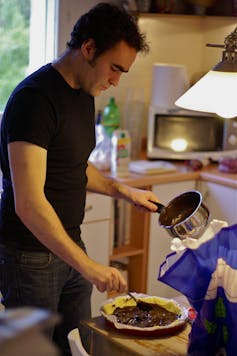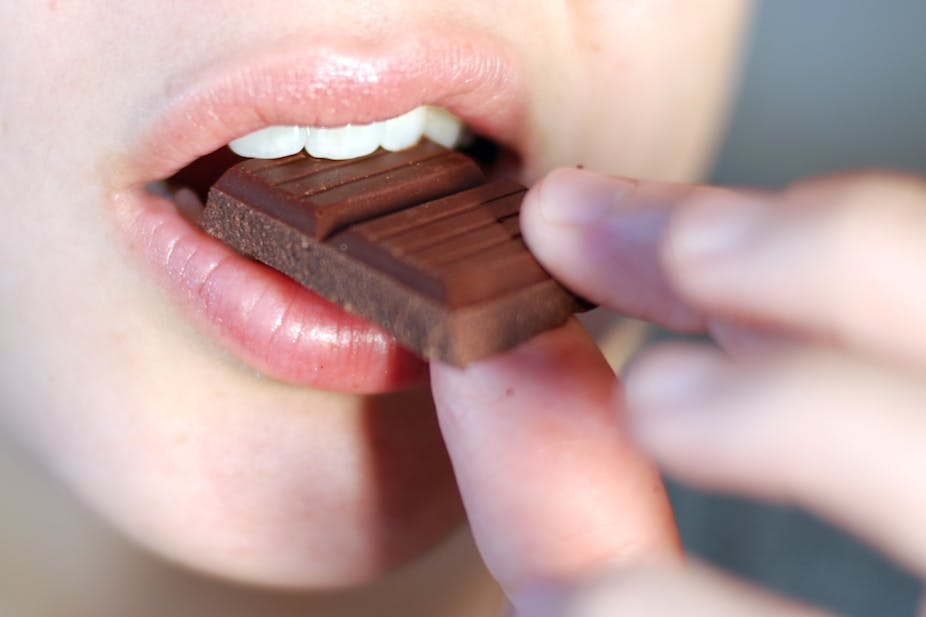Outbreaks of pimples, blackheads and cysts are a cause of enormous anxiety and embarrassment among teens and young adults. If you’re part of the 20% of Australians who have experienced severe acne, you’ve probably tried a raft of treatments and preventive measures. But does giving up chocolate help?
It’s unclear where or how this myth arose, but researchers tested the link three times from 1965 to 1971, suggesting it must have been a commonly held belief at least 40 years ago. All three studies came up with the answer: chocolate doesn’t exacerbate acne.
But by today’s standards, the investigations were all of a poor scientific standard. The original study, conducted in 1965, contained just eight participants.
The next study, published in Journal of the American Medical Association in 1969, had 65 participants, but the results were confounded by the use of two different groups of subjects: 60 adolescents (14 girls) and 35 young adult male prisoners of an unspecified age. The researchers didn’t account for the effects of gender, age, puberty, menstrual cycles, stress, smoking, lifestyle, background dietary intake or medical conditions affecting the skin.
The 1971 study, published in the journal American Family Physician, evaluated the effects of chocolate, milk, roasted peanuts and cola on acne in 27 students, but it failed to report their age and only followed them for one week. Also, it didn’t address all potential confounders and failed to report significant acne outbreaks during or immediately after the study period.

Several detailed critiques of these studies’ shortcomings have since been published. But the chocolate and acne myth has remained controversial and unchallenged since.
A recent study of YouTube videos found more than 85% of clips with keywords acne, “acne diet” and acne food" supported the belief that diet has a moderate association with acne.
So why does the myth that chocolate causes acne continue to circulate?
Perhaps the fault lies with us as researchers as the protagonists of evidence-based practice. We have failed to subject this chocolate myth to the rigours of a randomised control trial (RCT), despite the fact that almost all people aged 15 to 17 years experience some degree of acne. We need a decent RCT so we can know once and for all whether to unleash our teenagers, and ourselves, in the confectionery aisle at the supermarket.
Food and acne
Recent evidence suggests it may be time to expand our investigation of chocolate and acne and focus on milk consumption and the glycemic index (GI).
Milk and its products, including pasteurised milk, yoghurt, ice cream and cottage cheese, contain an array of naturally occurring ingredients that promote growth. The whey protein of dairy products, with the exception of cheese, leads to an increased release of insulin. And the casein protein in dairy products leads to an increase in levels of insulin-like growth factor (IGF).
Surprisingly, drinking milk raises blood insulin levels to a greater degree than predicted, based solely on its lactose content (the carbohydrate found in milk). Although the biochemical pathways are complex, in simple terms, this can lead to a worsening of acne.
This same reaction does not occur after eating cheese.

Glycemic Index and Glycemic Load
Diets with a high glycemic index (GI) or glycemic load (GL) trigger a higher insulin response. This is because high-GI foods contain carbohydrate in a form that is quickly digested and absorbed into the blood stream, sending a message to the pancreas to secrete insulin.
This high level of insulin, in turn, increases IGF, potentially exacerbating acne. The insulin then sets out to clear the glucose from the blood.
So can a high GL diet, with more high-GI foods, help manage acne?
This was tested in a 2007 randomised control trial. The researchers asked 43 males aged 18 years to follow either a low-GL or a high-GL diet for 12 weeks. Meanwhile, the severity of their acne was assessed by dermatologists who were blinded to the dietary intervention aspects of the study.
The low-GL groups were instructed to swap some high-GI foods for others higher in protein, such as lean meat, chicken, or fish, and to favour lower-GI foods such as, wholegrain bread, pasta, and fruits. The low-GL diet aimed for 25% energy from protein, 45% from low-GI carbohydrates, and 30% energy from fats. The high-GL group was encouraged to follow a high-carbohydrate diet.
Interestingly, those following the low-GL diet saw their acne improve, along with their insulin sensitivity. They also lost weight. It’s important to note, however, that this work has not been repeated by other researches at this stage.
What to do if you suffer from acne
Acne commonly persists into adulthood, with almost two-thirds of adults in their 20s and 43% in their 30s experiencing the condition. No matter what your age, you can get help from your GP who may need to refer you to a dermatologist.
When it comes to food, more good quality research studies are needed to assess the impact of dietary manipulations. But along with medical treatment, there are some dietary strategies worth trying:
Reduce your intake of high GI carbohydrate foods, such as potatoes, doughnuts, pancakes, sweetened breakfast cereal, and white bread. Swap high GI for lower GI choices such as apples, bananas, carrots, corn, muesli, mixed grain bread, pasta, porridge, tomato soup, sweet potato.
Be more active to improve insulin sensitivity; go for a short walk after eating to help reduce blood sugars and moderate insulin levels.
Reduce your milk (but not cheese) intake. To achieve peak bone mass you will need to take a daily calcium supplement.
If you’re overweight, try and reduce your weight, even by a few kilograms.

